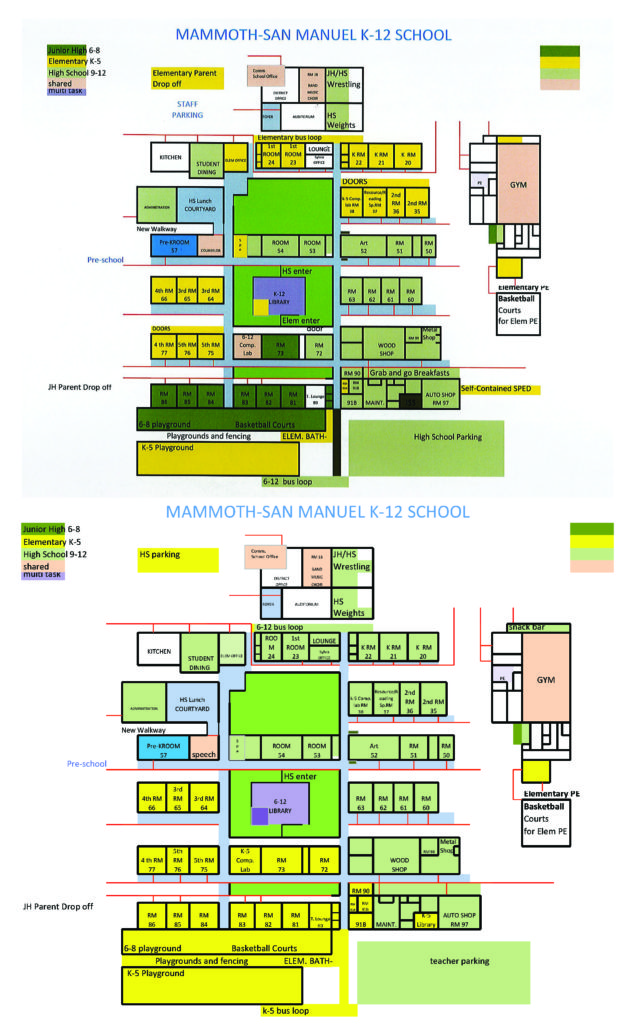In the face of declining student enrollment and massive reductions in funding, the Mammoth-San Manuel Unified School District Governing Board is once again facing a decision that would mothball two more campuses.
The board is considering creating a centralized campus for pre-K-12. Pending final approval, all students will be housed at the San Manuel Jr.-Sr. High School.
The Mammoth STEM and First Avenue Elementary Schools will be closed.
The time frame? All work and the schools unified at one campus by August 2018, in time for the beginning of school.
On Saturday, March 3, the board held a meeting in the district auditorium to hear from residents, parents and teachers about the proposed campus unification.
A few spoke out against the unification, fearing that putting younger students with older students would create a harmful atmosphere for the more vulnerable students.
Annie Martinez, a parent who lives in Mammoth, cited recent school violence at middle schools and high schools in Coolidge and Casa Grande. She is concerned that bullying of younger students may result in injuries or even suicide.
“What is the cost of an elementary school child’s life?” she asked the board members.
Junior high English teacher Denise Fisher disagreed with the idea that older students would bully or harm younger students they might come in contact with on campus.
“I think our older kids will rise to this,” she said. “We have good kids.”
She has spoken at length with her students about the possible transition and most were excited about the prospect, asking if they could start a reading program with the younger students and whether they could help out in the elementary classrooms.
“This is about helping out kids,” she said.
Martinez did agree that a K-12 school could work, but that the board needed to take its time and not do everything in a couple of months.
Debbie Mansager, a teacher at First Avenue Elementary School and former teacher at Mammoth Elementary School, agreed that it could be done, but not by August.
“It needs to be done slowly,” she said.
She suggested doing the unification in stages, leaving one elementary school open while the classrooms are renovated at the Jr./Sr. high school to accommodate the younger students.
But the school district may not have time.
Terry Newman, the M-SM School Board President, admitted that this decision is entirely about numbers and boils down to: “How much money do we have for our kids’ education?”
The school district is aging. Buildings that are considered “brand new” are actually 30 years old. Heating and cooling equipment, likewise, are aging.
At First Avenue Elementary School, the A/C units are 20 years old and will need to be replaced if the district intends to keep using the campus. The cost? The district would need to replace 32 A/C units at a cost of $8,000 each for a total of $256,000.
Mammoth Elementary also has its own set of issues. The administration has estimated that to bring Mammoth Elementary School to full capacity is estimated at nearly $500,000.
• The A/C and heating units in the band-lab area were struck by lightning and the cost to replace is $30,000.
• The gym boiler is non-repairable and the cost to replace is $50,000.
• The gym coolers are not functioning at this time. One is repairable at a cost of $8,000 and the remaining ones need to be replaced ($30,000).
• The cafeteria roof needs replacing. $51,000
• All of the classroom A/C units were installed in 1999-2000 and are at the end of their serviceability. The cost to replace all 36 units is $288,000. On the classrooms still in use, the district has had to replace three compressors and several fan motors.
Enrollment in the district has been on a steady decline since the mine closed in the late 1990s. In 2000, when the district closed Gardner Middle School, enrollment was 1,249. Enrollment slipped to 1,100 when the district closed Avenue B. In 2009, when the district reduced the enrollment at Mammoth Elementary School and created the STEM school, enrollment in the district was 1,049. Enrollment is now 710.
Along with the decline in enrollment, there has been a significant decline in funding to the district. From 2013 to 2018, funding for the district has gone from $5,478,266 to $5,191,321, a decrease of nearly $300,000. Federal funds for special education students and Title I and II, have decreased by 10% yearly.
The district, like other small and large businesses, have had to adjust for an increase in the minimum wage and increases in the costs of fuel, utilities, food, etc.
The cost of running each of the facilities:
• Mammoth Elementary School – $475,000
• First Avenue Elementary School – $1,400,000
• Jr./Sr. High School – $1,800,000
Unification, School Superintendent Julie Dale-Scott explained to the members of the public attending Saturday’s hearing, “puts budget money into the students rather than the buildings.”
“Schools are central to this community,” Newman said. “We need to take this on as a community.”
The governing board seems resigned to the unification. But the biggest question is what is an appropriate time frame.
“We’re not saying that three months is a viable time frame,” Newman said, “just that it’s a time frame.”
The board must make a decision at next week’s board meeting. The meeting is set for 6:30 p.m. on Tuesday, March 13, at the district office. The public will have the opportunity to address the board during the Call to the Public.
There is still time to participate in an online survey. www.msmusd.org. Budget and enrollment information and a downloadable version of the two proposed maps can be found here: http://bit.ly/2FZmE6k

Two different proposals for how a unified campus would look. The top map represents what the administration has proposed. The bottom is what staff has proposed.
